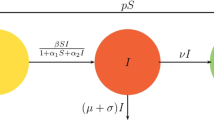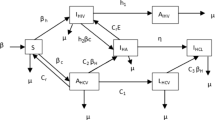Abstract
The purpose of this work is to investigate a novel stochastic SIHR epidemic model, which includes a general incidence rate and mean-reversion Ornstein–Uhlenbeck process. Firstly, the existence of global positivity of the solution is testified by Lyapunov function. Secondly, this disease will be eradicated if the reproduction number \(\mathcal {R}_{0}^{s}<1\). Otherwise, if the reproduction number \(\mathcal {R}_{0}^{*}>1\), then the system has a stationary distribution, which means that the pandemic will persist. In addition, an explicit expression of the probability density function for a linear system near quasi-endemic equilibrium is obtained under certain conditions. Finally, a series of numerical simulations is carried out to validate the theoretical conclusions.






Similar content being viewed by others
Data availability
The data that support the findings of this study are available from the corresponding author upon reasonable request.
References
Glasser, J., Meltzer, M., Levin, B.: Mathematical modeling and public policy: responding to health crises. Emerg. Infect. Dis. 10(11), 2050–2051 (2004)
Jiao, S., Huang, M.: An SIHR epidemic model of the COVID-19 with general population-size dependent contact rate. AIMS Math. 5(6), 6714–6725 (2020)
Souleiman, Y., Mohamed, A., Ismail, L.: Analysis the dynamics of SIHR model: Covid-19 case in Djibouti. Appl. Math. 12(10), 867–881 (2021)
Zhang, X., Zhang, X.: The threshold of a deterministic and a stochastic SIQS epidemic model with varying total population size. Appl. Math. Model. 91, 749–767 (2021)
Hou, T., Lan, G., Yuan, S., et al.: Threshold dynamics of a stochastic SIHR epidemic model of COVID-19 with general population-size dependent contact rate. Math. Biosci. Eng. 19(4), 4217–4236 (2022)
Adak, D., Majumder, A., Bairagi, N.: Mathematical perspective of COVID-19 pandemic: disease extinction criteria in deterministic and stochastic models. Chaos Solitons Fract. 142, 110381 (2020)
Zhang, X., Zheng, L.: Complex dynamics of a stochastic SIR epidemic model with vertical transmission and varying total population size. J. Nonlinear Sci. 33(108), 1 (2023). https://doi.org/10.1007/s00332-023-09960-8
He, S., Tang, S., Rong, L.: A discrete stochastic model of the COVID-19 outbreak: Forecast and control. Math. Biosci. Eng. 17(4), 2792–2804 (2020)
Faranda, D., Castillo, I., Hulme, O., et al.: Asymptotic estimates of SARS-CoV-2 infection counts and their sensitivity to stochastic perturbation. Chaos 30(5), 051107 (2020)
Zhang, X., Yuan, R.: A stochastic chemostat model with mean-reverting Ornstein–Uhlenbeck process and Monod-Haldane response function. Appl. Math. Comput. 394, 125833 (2020)
Laaribi, A., Boukanjime, B., El Khalifi, M., et al.: A generalized stochastic SIRS epidemic model incorporating mean-reverting Ornstein–Uhlenbeck process. Physica A 615, 128609 (2023)
Zhang, X., Yuan, R.: A stochastic chemostat model with mean-reverting Ornstein–Uhlenbeck process and Monod-Haldane response function. Appl. Math. Comput. 394, 125833 (2021)
Ayoubi, T., Bao, H.: Persistence and extinction in stochastic delay Logistic equation by incorporating Ornstein–Uhlenbeck process. Appl. Math. Comput. 386, 125465 (2020)
Wang, W., Cai, Y., Ding, Z., et al.: A stochastic differential equation SIS epidemic model incorporating Ornstein–Uhlenbeck process. Physica A 509, 921–936 (2018)
Zhou, B., Jiang, D., Han, B., et al.: Threshold dynamics and density function of a stochastic epidemic model with media coverage and mean-reverting Ornstein-Uhlenbeck process. Math. Comput. Simul. 196, 15–44 (2022)
Win, Z., Eissa, M., Tian, B.: Stochastic epidemic model for COVID-19 transmission under intervention strategies in China. Mathematics 10(17), 3119 (2022)
Qi, K., Jiang, D.: The impact of virus carrier screening and actively seeking treatment on dynamical behavior of a stochastic HIV/AIDS infection model. Appl. Math. Model. 85, 378–404 (2020)
Zhou, B., Jiang, D., Dai, Y., et al.: Threshold dynamics and probability density function of a stochastic avian influenza epidemic model with nonlinear incidence rate and psychological effect. J. Nonlinear Sci. 33(2), 1–52 (2023)
Gardiner, C.W.: Handbook of Stochastic Methods for Physics. Springer, Berlin (1983)
Mao, X.: Stochastic Differential Equations and Applications, 2nd edn. Horwood Publishing (1997)
Higham, D.: An algorithmic introduction to numerical simulation of stochastic differential equations. SIAM Rev. 43(3), 525–546 (2001)
Vasconcelos, G., Pessoa, N., Silva, N., et al.: Multiple waves of COVID-19: a pathway model approach. Nonlinear Dyn. 111, 6855–6872 (2023)
de Lima Gianfelice, P.R., Oyarzabal, Sovek, Cunha, R., et al.: The starting dates of COVID-19 multiple waves. Chaos Interdiscip. J. Nonlinear Sci. 32(3), 031101 (2022)
Sebastian, N., Nair, S., Joseph, D.: An overview of the pathway idea and its applications in statistical and physical sciences. Axioms 4(4), 4040530 (2015)
Acknowledgements
The work is supported by the National Natural Science Foundation of China (Nos. 11671236, 11871473) and the Fundamental Research Funds for the Central Universities, China (Nos. 22CX03013A, 22CX03030A).
Author information
Authors and Affiliations
Contributions
XM: Software, Validation, Formal analysis, Investigation, Data curation, Writing-original draft, Writing-review & editing. DJ: Conceptualization, Methodology, Validation, Formal analysis, Visualization, Supervision, Funding acquisition.
Corresponding author
Ethics declarations
Conflict of interest
The authors declare that they have no Conflict of interest.
Additional information
Publisher's Note
Springer Nature remains neutral with regard to jurisdictional claims in published maps and institutional affiliations.
Rights and permissions
Springer Nature or its licensor (e.g. a society or other partner) holds exclusive rights to this article under a publishing agreement with the author(s) or other rightsholder(s); author self-archiving of the accepted manuscript version of this article is solely governed by the terms of such publishing agreement and applicable law.
About this article
Cite this article
Mu, X., Jiang, D. A stochastic SIHR epidemic model with general population-size dependent contact rate and Ornstein–Uhlenbeck process: dynamics analysis. Nonlinear Dyn (2024). https://doi.org/10.1007/s11071-024-09586-9
Received:
Accepted:
Published:
DOI: https://doi.org/10.1007/s11071-024-09586-9




